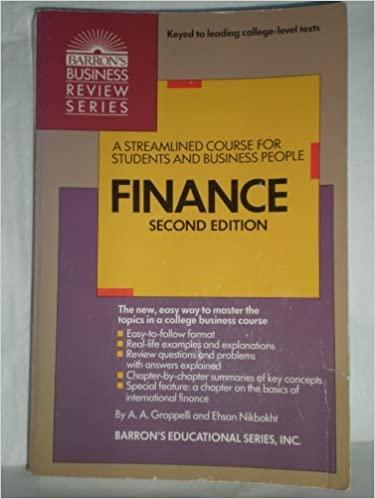Question
Suppose that you are a mutual fund manager. Your fund invests in a diversified portfolio of small cap common stocks. Your benchmark is the Russell
Suppose that you are a mutual fund manager. Your fund invests in a diversified portfolio of small cap common stocks. Your benchmark is the Russell 2000 Index. The Russell 2000 Index is designed to measure the performance of the bottom 2,000 companies from a universe of the 3,000 largest stocks in the U.S.
Your fund recently received $8,840,000 in cash to invest in common stocks. You could immediately invest the cash in additional shares of stocks that your fund currently holds for reasons consistent with your funds objective. However, you have concerns that the stock market has significant risk of a major correction in the near future. You are concerned that if you buy stocks today, then these shares will be at risk of significant decline in value in the short run.
Thus, you plan to implement the strategy using call options to protect against downside risk for a future purchase. (Hint: see Section C in Lecture 7A.)
You plan to delay the purchase of stocks for your fund for 2 months.
Here is the market information when you implement your strategy.
- Currently, the spot market value of the Russell 2000 Index is 2210.
- A call option on the Russell 2000 Index has a contract multiplier of $100. (This option is cash settled in the same way as call options on the S&P 500 index.)
- For call options with a strike price of 2210 that expire on the future date when you plan to buy the stocks, the premium currently is $55.60.
- The continuously compounded, annualized risk free rate for this scenario is 2.54%.
Now jump ahead in time to the date when you buy the small cap common stocks for your mutual fund and when the call option expires. Suppose that the Russell 2000 index is 1,463. What is your funds total profit or loss on his strategy?
NOTE: apply the exact formula or calculation. Do not approximate by treating the risk-free rate as zero.
HINT: recall that we can think of the index value as if it were a share price. We can think of the index multiplier as if it were number of shares underlying the index call option.
Step by Step Solution
There are 3 Steps involved in it
Step: 1

Get Instant Access to Expert-Tailored Solutions
See step-by-step solutions with expert insights and AI powered tools for academic success
Step: 2

Step: 3

Ace Your Homework with AI
Get the answers you need in no time with our AI-driven, step-by-step assistance
Get Started


